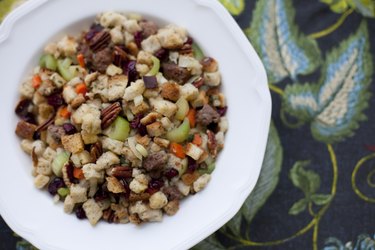
Stuffing recipes are often a topic of friendly debate as Thanksgiving dinner plans get underway. Bread or cornbread, or maybe even both? Then there's oysters and apples, chestnuts and rice, celery and onions – the possibilities are endless.
How Is Stuffing Used?
Video of the Day
Dressing, stuffing and even filling all mean the same thing, though which name you use may depend on what part of the country you're from. Some cooks insist that stuffing goes inside the turkey, while dressing is cooked outside the bird.
Video of the Day
Of course, turkey isn't the only dish stuffed with a savory combination of ingredients. Thick-cut pork chops and chicken breasts lend themselves to a savory filling. Braciole, flank steak rolled around a filling of cheese and bread crumbs, is an Italian classic.
You can reheat leftovers in the oven, on the stovetop or in the microwave.
Reheating Stuffing in the Oven
One of the drawbacks to reheating stuffing is the possibility that it will dry out, leaving you with a less-appetizing side dish. You can avoid this by adding chicken or vegetable stock to the dressing before you put it in the oven. The amount you add depends on how much stuffing you're reheating, but a rule of thumb is to add just enough to make it moist but not wet.
Heat the oven to 325 degrees Fahrenheit. Put the stuffing in a shallow pan or baking dish, add stock and stir to blend. Cover the pan with aluminum foil and bake.
Check the internal temperature with a food thermometer inserted at the center after about 20 minutes. If the temperature hasn't reached 165 degrees Fahrenheit, return the stuffing to the oven until it reaches a safe temperature. Add more stock if needed.
Microwaving Leftover Stuffing
The best way to cook stuffing in the microwave is to put it in a microwave-safe bowl with a lid. Add enough chicken or vegetable stock to make it moist but not wet and microwave it on high for two or three minutes. If you don't have a bowl with a lid, cover the dish loosely with plastic wrap.
After two or three minutes, stir the stuffing and check the internal temperature with a food thermometer. If the temperature hasn't reached 165 degrees Fahrenheit, return the bowl to the microwave and cook for another few minutes or until the thermometer reads 165.
Stovetop Dressing Reheating
Coat the bottom of a skillet with a thin layer of butter. Add the dressing and enough chicken or vegetable stock to moisten, and then cover the skillet and set it on medium heat. Stir the dressing every few minutes and add vegetable or chicken stock if necessary. Your side dish is ready when the internal temperature is 165 degrees Fahrenheit.
You can avoid the extra fat and calories butter adds by using a nonstick pan and stirring frequently, by using cooking spray instead or by using a healthy oil like canola or olive oil. Keep in mind that some oils will impart their flavor to the stuffing.
Stuffing Tips
- Scoop the stuffing out of the turkey cavity after the turkey has rested for 20 minutes to prevent the growth of bacteria.
- Small amounts of stuffing, such as in a stuffed pork chop or chicken breast, can be refrigerated as is.
- Use refrigerated leftover stuffing within two to four days.
- Freeze leftover stuffing for up to a month in freezer containers or wrapped in heavy-duty aluminum foil or freezer paper. Don't thaw the stuffing before reheating. Remember to write the date on the container.
- Don't stuff the turkey until you're ready to put it in the oven.
- Remember the two hour rule – refrigerate or freeze leftovers within two hours of serving.
- Don't reheat stuffing in a slow cooker because it will heat too slowly, allowing bacteria to grow.
- If you don't have chicken or vegetable stock on hand, substitute water.
- United States Department of Agriculture Food Safety and Inspection Service: Stuffing and Food Safety
- University of Georgia Media Newswire: Sandwiches? Turkey Soup? Don’t Let Those Leftovers Linger Too Long
- University of Illinois Extension: Turkey for the Holidays: Stuffing Safely
- Food Network: Braciole